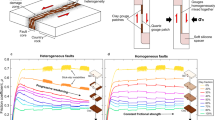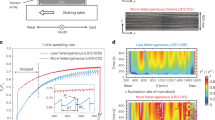Abstract
Slip on unfavourably oriented faults with respect to a remotely applied stress is well documented and implies that faults such as the San Andreas fault1 and low-angle normal faults2 are weak when compared to laboratory-measured frictional strength3. If high pore pressure within fault zones is the cause of such weakness, then stress reorientation within or close to a fault is necessary to allow sufficient fault weakening without the occurrence of hydrofracture4. From field observations of a major tectonic fault, and using laboratory experiments and numerical modelling, here we show that stress rotation occurs within the fractured damage zone surrounding faults. In particular, we find that stress rotation is considerable for unfavourably oriented ‘weak’ faults. In the ‘weak’ fault case, the damage-induced change in elastic properties provides the necessary stress rotation to allow high pore pressure faulting without inducing hydrofracture.
This is a preview of subscription content, access via your institution
Access options
Subscribe to this journal
Receive 51 print issues and online access
$199.00 per year
only $3.90 per issue
Buy this article
- Purchase on Springer Link
- Instant access to full article PDF
Prices may be subject to local taxes which are calculated during checkout




Similar content being viewed by others
References
Zoback, M. D. et al. New evidence on the state of stress of the San Andreas fault system. Science 238, 1105–1111 (1987)
Colletini, C. & Sibson, R. H. Normal faults, normal friction? Geology 29, 927–930 (2001)
Byerlee, J. D. Friction of rocks. Pure Appl. Geophys. 116, 615–629 (1978)
Rice, J. R. in Fault Mechanics and Transport Properties of Rocks (eds Evans, B. & Wong, T.-f.) 475–503 (Academic Press, San Diego, CA, 1992)
Lachenbruch, A. H. & Sass, J. H. Heat flow and energetics of the San Andreas fault zone. J. Geophys. Res. 85, 6185–6223 (1980)
Sibson, R. H. An assessment of field evidence for “Byerlee” friction. Pure Appl. Geophys. 142, 645–662 (1993)
Morrow, C. A., Moore, D. E. & Lockner, D. A. The effect of mineral bond strength and absorbed water on fault gouge frictional strength. Geophys. Res. Lett. 27, 815–819 (2000)
Wibberley, C. A. J. & Shimamoto, T. Earthquake slip weakening and asperities explained by thermal pressurization. Nature 436, 689–692 (2005)
Di Toro, G., Hirose, T., Nielsen, S., Pennacchioni, G. & Shimamoto, T. Natural and experimental evidence of melt lubrication of faults during earthquakes. Science 311, 647–650 (2006)
Byerlee, J. D. Friction, overpressure and fault-normal compression. Geophys. Res. Lett. 17, 2109–2112 (1990)
Faulkner, D. R. & Rutter, E. H. Can the maintenance of overpressured fluids in large strike-slip fault zones explain their apparent weakness? Geology 29, 503–506 (2001)
Hardebeck, J. L. & Hauksson, E. Role of fluids in faulting inferred from stress field signatures. Science 285, 236–239 (1999)
Provost, A-S. & Houston, H. Orientation of the stress field surrounding the creeping section of the San Andreas fault: Evidence for a narrow mechanically weak fault zone. J. Geophys. Res. 106, 11373–11386 (2001)
Lockner, D. A. & Byerlee, J. D. How geometrical constraints contribute to the weakness of mature faults. Nature 363, 250–252 (1993)
Scholz, C. H. Evidence for a strong San Andreas fault. Geology 28, 163–166 (2000)
Chester, F. M., Evans, J. P. & Biegel, R. L. Internal structure and weakening mechanisms of the San Andreas fault. J. Geophys. Res. 98, 771–786 (1993)
Faulkner, D. R., Lewis, A. C. & Rutter, E. H. On the internal structure and mechanics of large strike-slip faults: field observations from the Carboneras fault, southeastern Spain. Tectonophysics 367, 235–251 (2003)
Cembrano, J. et al. Fault zone development and strain partitioning in an extensional strike-slip duplex: a case study from the Atacama Fault System, northern Chile. Tectonophysics 400, 105–125 (2005)
Townend, J. & Zoback, M. D. How faulting keeps the crust strong. Geology 28, 399–402 (2000)
Vermilye, J. & Scholz, C. H. The process zone; a microstructural view of fault growth. J. Geophys. Res. 103, 12223–12237 (1998)
Anders, M. H. & Wiltschko, D. V. Microfracturing, paleostress and the growth of faults. J. Struct. Geol. 16, 795–815 (1994)
Wilson, J. E., Chester, J. S. & Chester, F. M. Microfracture analysis of fault growth and wear processes, Punchbowl Fault, San Andreas system, California. J. Struct. Geol. 25, 1855–1873 (2003)
Rice, J. R., Sammis, C. G. & Parsons, R. Off-fault secondary failure induced by a dynamic slip pulse. Bull. Seismol. Soc. Am. 95, 109–134 (2005)
Ayling, M. R., Meredith, P. G. & Murrell, S. A. F. Microcracking during triaxial deformation of porous rocks monitored by changes in rock physical properties. I. Elastic-wave propagation measurements on dry rocks. Tectonophysics 245, 205–221 (1995)
Casey, M. Mechanics of shear zones in isotropic dilatant materials. J. Struct. Geol. 2, 143–147 (1980)
Jaeger, J. C. & Cook, N. G. W. Fundamentals of Rock Mechanics 11–17 (Chapman and Hall, London, 1976)
Heap, M. J. & Faulkner, D. R. Quantifying the evolution of static elastic properties as crystalline rock approaches failure. J. Struct. Geol. (submitted).
Acknowledgements
We thank J. Cembrano for field assistance and M. Casey, N. Kusznir and D. Prior for discussions. This work was supported by the Natural Environment Research Council and the Nuffield Foundation.
Author information
Authors and Affiliations
Corresponding author
Ethics declarations
Competing interests
Reprints and permissions information is available at www.nature.com/reprints. The authors declare no competing financial interests.
Rights and permissions
About this article
Cite this article
Faulkner, D., Mitchell, T., Healy, D. et al. Slip on 'weak' faults by the rotation of regional stress in the fracture damage zone. Nature 444, 922–925 (2006). https://doi.org/10.1038/nature05353
Received:
Accepted:
Issue Date:
DOI: https://doi.org/10.1038/nature05353
This article is cited by
-
Analysis of Near-Field Stresses in an Analogue Strike-Slip Fault Model
Rock Mechanics and Rock Engineering (2024)
-
Controls of strike-slip fault on fractures: Insight from 3D discrete element simulation
Science China Earth Sciences (2024)
-
Measurement and Assessment of the In-Situ Stress of the Shazaoyuan Rock Block, a Candidate Site for HLW Disposal in Northwest China
Rock Mechanics and Rock Engineering (2024)
-
Syn-exhumation metasomatic glaucophane-phengite-quartz veins formed at moderate pressures: exploring the control of fO2 and bulk composition on nominally HP metamorphic assemblages
Contributions to Mineralogy and Petrology (2024)
-
Damage amplification during repetitive seismic waves in mechanically loaded rocks
Scientific Reports (2023)
Comments
By submitting a comment you agree to abide by our Terms and Community Guidelines. If you find something abusive or that does not comply with our terms or guidelines please flag it as inappropriate.



